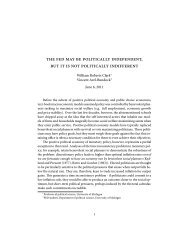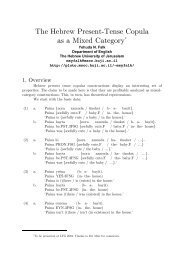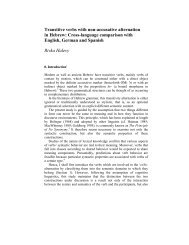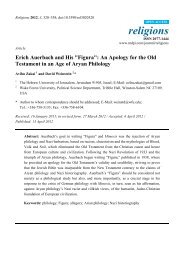View - Pluto Huji Ac Il
View - Pluto Huji Ac Il
View - Pluto Huji Ac Il
You also want an ePaper? Increase the reach of your titles
YUMPU automatically turns print PDFs into web optimized ePapers that Google loves.
B. On posterior distributions<br />
The following propositions describe several simple but interesting properties of the posterior<br />
distributions under the model θi = θ for all i.<br />
Let X|θ ∼ Bin(n, θ) and θ ∼ Π, any prior, and for x = 0, . . . , c let Πn(·|x) be the<br />
posterior cdf of θ|X ∗ c = x, where X ∗ c has the distribution of X|X ≤ c, for some fixed c.<br />
Proposition .1. The sequence of distributions {Πn(·|x)}n>c is stochastically decreasing in<br />
n for 0 ≤ x ≤ c, that is, Πn−1(θ|x) ≤ Πn(θ|x) for all 0 < θ < 1 and all n > c.<br />
Also, for any n > c, Πn(·|x) is stochastically larger than Π for x = c, and smaller for<br />
x = 0.<br />
Proof. We prove the stronger likelihood ratio order. The posterior density associated with<br />
Πn(θ|x) is<br />
πn(θ|x) =<br />
n x n−x θ (1 − θ) /Fθ(c; n)<br />
x<br />
π(θ),<br />
tx (1 − t) n−x /Ft(c; n)]π(t)dt<br />
(7)<br />
1<br />
0 [ n<br />
x<br />
where Fθ(c; n) = Pθ(X ≤ c) denotes the Bin(n, θ) distribution function at c. Direct calculations<br />
show that πn(θ|x)/πn−1(θ|x) ∝ (1 − θ)Fθ(c; n − 1)/Fθ(c; n), and the first part<br />
of the proposition will be proved if we show that the last expression is non-increasing in<br />
θ. Writing (1 − θ)Fθ(c; n − 1) = c n x n−x<br />
x=0 θ (1 − θ) (n − x)/n, it is readily seen that<br />
x<br />
(1 − θ)Fθ(c; n − 1)/Fθ(c; n) = Eθ {(n − X ∗ c )/n}. The problem reduces to showing that<br />
Eθ(X ∗ c ) increases in θ, which follows from Lemma .1.<br />
For the second part of the proposition note that by (7), πn(θ|0)/π(θ) ∝ Pθ(X ∗ c ≤ 0),<br />
which by Lemma .1 is non-increasing in θ, proving likelihood ratio order. Similarly, for<br />
x = c we use the relation πn(θ|c)/π(θ) ∝ 1 − Pθ(X ∗ c ≤ c − 1).<br />
Proposition .2. For 0 ≤ x ≤ c we have:<br />
(i) If EΠ( 1<br />
θ )c−x = ∞, then limn→∞ Πn(θ | x) = I{θ ≥ 0}, the cdf of a r.v. degenerate at 0.<br />
(ii) If EΠ( 1<br />
θ )c−x < ∞, then limn→∞ Πn(θ | x) ∝ θ 1−t ( 0 t )c−xπ(t)dt. Proof. For θ > 0 we obtain by writing Ft(c; n) in (7) explicitly and straightforward cancellations<br />
1<br />
1 − Πn(θ|x) = πn(t|x)dt =<br />
θ<br />
<br />
1 c<br />
θ<br />
<br />
1 c<br />
0<br />
k=0<br />
k=0<br />
1−t ( t )x−k [ n k<br />
1−t ( t )x−k [ n k<br />
n<br />
/ ]<br />
c<br />
n<br />
/ ]<br />
c<br />
−1<br />
−1<br />
π(t)dt<br />
.<br />
π(t)dt<br />
For k < c, n n<br />
/ → 0 monotonically as n → ∞. Therefore, each of the integrands<br />
k c<br />
(with respect to π) above, converges to ( 1−t<br />
t )c−x . By monotone convergence, the integral<br />
t )c−xπ(t)dt which is always finite. The integral in the<br />
t )c−xπ(t)dt. If the latter integral diverges, the resulting<br />
in the numerator converges to 1 1−t ( θ<br />
denominator converges to 1 1−t ( 0<br />
distribution Πn(θ|x) is clearly degenerate at 0, and (i) follows. Otherwise, (ii) obtains.<br />
We conclude by discussing some interesting implications of Proposition .2. For x = c the<br />
condition in (ii) holds trivially, and we have convergence to the prior, that is, limn→∞ Πn(θ |<br />
c) = Π(θ) for all θ. Focusing for simplicity on the case of c = 1, we see that observing<br />
X ∗ = 1 for large n, leads a Bayesian to stick to his prior. The frequentist also sees this<br />
observations as almost non informative, as reflected by the interval (3), which converges to<br />
[0, 1].<br />
10



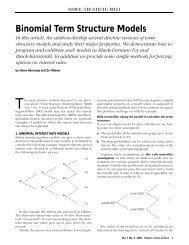
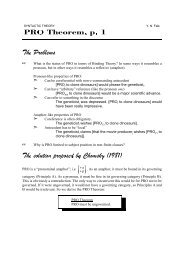
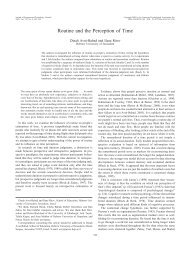
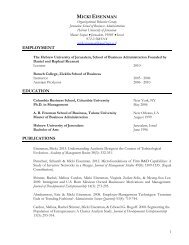
![CV [PDF] - Pluto Huji Ac Il](https://img.yumpu.com/18174585/1/190x245/cv-pdf-pluto-huji-ac-il.jpg?quality=85)


